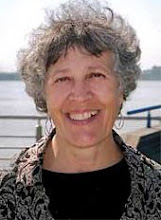Tuesday, March 10, 2009
To the Library
What Darwin Saw: The Journey That Changed the World by Rosalyn Schanzer (National Geographic, 2009) In her Author's Note, Schanzer tells readers that she "loved everything about making this book." She traveled & took over 3,000 pictures and did "reading, reading, and more reading." Her decision to use "a graphic novel layout with lots of diagonals" resulted in a book replete with her illustrations--as many as 10 separate images (some realistic, many cartoonish) on a two-page spread--many quotes (some in quote bubbles) and her own minimalist text. Abridged quotes from Darwin's various writings appear in brown type, quotes from everyone else are orange, and the author's text is black (that hard-to-find information is provided on the title page in a bird's dialogue bubbles). To make sense of everything, I had to skim, read, and reread the book. Soliciting other opinions, I showed it to Linda Hickson, special education professor, Teachers College, Columbia University; Sue Kirch, science educator, New York University; and the graduate students in two of my classes (“Issues in Children’s Literature” and “Nonfiction Literature for Children” ) at Queens College; to a person they agreed that the format was overwhelming; so much so that it limited the appeal and/or usefulness of the book. If you do decide to teach with the book, here are some sequential suggestions: brief students about Darwin and his importance; underscore the fact that the book features his journey on a ship, the H.M.S. Beagle; explain why that journey is important; examine the map in the end matter; read the black text (author's narrative) all the way through (before scrutinizing the illustrations and quotes); read the information in the bird bubble on the title page. Also my graduate students noted some advanced vocabulary words; so have a dictionary handed. If you have comments, please feel free to add them.
Labels:
On Reading,
Teaching with Nonfiction
Subscribe to:
Post Comments (Atom)

No comments:
Post a Comment